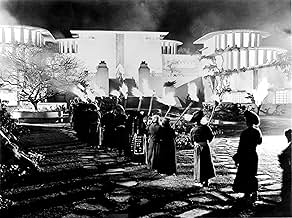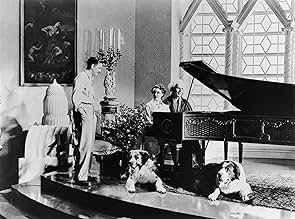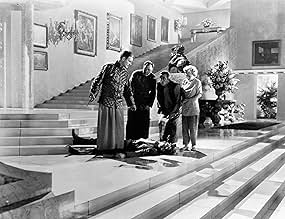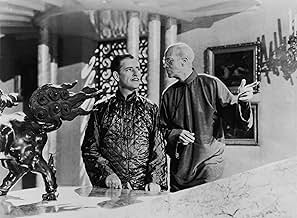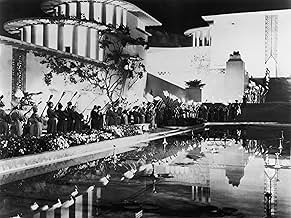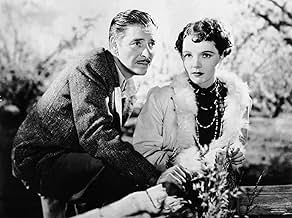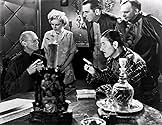IMDb-BEWERTUNG
7,6/10
14.854
IHRE BEWERTUNG
Füge eine Handlung in deiner Sprache hinzuWhen a revered diplomat's plane is diverted and crashes in the peaks of Tibet, he and the other survivors are guided to an isolated monastery at Shangri-La, where they wrestle with the invit... Alles lesenWhen a revered diplomat's plane is diverted and crashes in the peaks of Tibet, he and the other survivors are guided to an isolated monastery at Shangri-La, where they wrestle with the invitation to stay.When a revered diplomat's plane is diverted and crashes in the peaks of Tibet, he and the other survivors are guided to an isolated monastery at Shangri-La, where they wrestle with the invitation to stay.
- 2 Oscars gewonnen
- 3 Gewinne & 6 Nominierungen insgesamt
Norman Ainsley
- Embassy Club Steward
- (Nicht genannt)
Chief John Big Tree
- Porter
- (Nicht genannt)
Wyrley Birch
- Missionary
- (Nicht genannt)
Beatrice Blinn
- Passenger
- (Nicht genannt)
Hugh Buckler
- Lord Gainsford
- (Nicht genannt)
Sonny Bupp
- Boy Being Carried to Plane
- (Unbestätigt)
- (Nicht genannt)
John Burton
- Wynant
- (Nicht genannt)
Tom Campbell
- Porter
- (Nicht genannt)
Matthew Carlton
- Pottery Maker
- (Nicht genannt)
Handlung
WUSSTEST DU SCHON:
- WissenswertesThe year after this film was released the owner of a prosperous theater chain hired an architect who designed a mansion that was inspired by the Shangri-La lamasery in this film. Located in Denver, Colorado, it still exists today.
- PatzerEchoing the words of the critic, James Agate: 'The best film I've seen for ages, but will somebody please tell me how they got the grand piano along a footpath on which only one person can walk at a time with rope and pickaxe and with a sheer drop of three thousand feet or so?'
- Crazy CreditsBob Gitt of the UCLA Film & Television Archives claims the original opening sequence in 1937 had title cards "Conway has been sent to evacuate ninety white people before they're butchered in a local revolution" was changed in 1942 for a special reissue during WWII. The title cards read "before innocent Chinese people were butchered by Japanese hordes." This was to bolster propaganda against the Japanese.
- Alternative VersionenSome of the music in the restored version is dubbed into different sections than the ones in the 118 minute cut version. For example, the moment in which Robert Conway ('Ronald Colman') discovers that the High Lama is really Father Perrault i accompanied by soft music in the cut version, while in the restored version this moment is played with no music.
- VerbindungenEdited from Stürme über dem Mont Blanc (1930)
- SoundtracksWiegenlied (Lullaby) Op. 49 No. 4
(1868) (uncredited)
Composed by Johannes Brahms
English translator unknown
Sung a cappella by children at Shangri-La
Ausgewählte Rezension
One of my favorite books growing up was James Hilton's classic 1933 book, "Lost Horizon", and I believe it motivated a great deal of my current wanderlust. Even though I have had the misfortune of seeing the disastrous 1973 musical remake when I was young, the original 1937 film adaptation has been a film I have wanted to see for years, but for whatever reason, it was next to impossible to uncover. Apparently, bastardized versions have shown up on TV through the years. Now we are fortunate to have this 1999 restoration spearheaded by UCLA film archivist Robert Gitt to match as closely as possible to Frank Capra's original 132-minute running time.
Similar to what was done with George Cukor's "A Star Is Born", "Lost Horizon" is presented with its complete soundtrack, but missing footage had to be found through other sources, even 16-mm prints recorded from TV broadcasts, and in a few scenes, production stills were sadly the only option to fill in the gaps. Consequently, there is a variable quality to the print, but when one thinks that much of this footage could have been completely lost, the visual lapses are more than forgivable. Now that I have seen Capra's vision of the book, I can now understand why it's a cinematic classic though I have to concede not as timeless as one would hope.
The fanciful plot centers on Robert Conway, a top-level English diplomat about to become the Foreign Secretary, who helps refugees and assorted others from war-ravaged China. A motley crew of passengers led by Conway boards a plane that is skyjacked toward the Himalayas where it crash lands in a desolate spot of Tibet. They are eventually met by a sect of locals who takes them to a paradise called Shangri-La. The focus of the story then becomes how each of the plane survivors responds to this utopian existence. With his instantly recognizable mellifluous tone, Ronald Colman is perfectly cast as Conway, the only one who embraces this seemingly perfect haven from the outset. He captures the natural curiosity and open romanticism of his character with his trademark erudite manner.
The rest of the cast is a gallery of stock characters fleshed out by the variable quality of the performances. H.B. Warner plays Chang with the requisite serenity of his vague, mysterious character; and Jane Wyatt - two decades before playing the perfect suburban wife and mother in "Father Knows Best" - is surprisingly saucy as Sondra, the young schoolteacher who has Conway brought to Shangri-La. She even has a brief nude swimming scene. John Howard unfortunately overplays the thankless role of Conway's obstreperous brother George to the point where I groan every time he appears on screen. A similar feeling comes over me when I see Edward Everett Horton's overly pixilated and fey turn as Lovett and Sam Jaffe's bug-eyed, ethereal High Lama. Isabel Jewell and Thomas Mitchell fare better as a dying prostitute and a fugitive swindler, respectively.
The set designs for the Shangri-La lamasery by Stephen Goossón are intriguing in that they look like a post-modern tribute to Frank Lloyd Wright's prairie architecture, though one could argue that the exteriors also resemble a fancy Miami Beach resort hotel. I also imagine that the isolationist philosophy espoused by the High Lama may have been at odds with pre-WWII patriotic fervor, though the more lingering problem is the racism apparent in the casting (e.g., non-Asians like Warner playing inscrutable Asians) and the portrayal of the Tibetan porters as gun-toting derelicts. However, for all its flaws, the movie has some really stunning camera-work by Joseph Walker, surprisingly masterful special effects (for a near-poverty row studio like Columbia), Dmitri Tiomkin's stirring musical score and a powerful sense of mysticism that gives the film a genuine soul. It is no accident that Capra, the most idealistic of the master filmmakers, helmed this movie because a more cynical mindset could have easily sabotaged the entire venture.
The DVD is a wonderful package. First, there is a fascinating photo montage documentary with narration provided by film historian Kendall Miller, which gives a true feeling of how Capra approached the production. Gitt and film critic Charles Champlin provide audio commentary on an alternate track of the film with Gitt very informative about the exhaustive restoration process and Champlin more in awe of the result. There is even an alternative ending included that Columbia chief Harry Cohn insisted on filming and using upon release, but it had thankfully been dropped two weeks later. This is a genuine treat for cinemaphiles, as there are few films that make such a compelling case for seeking out one's personal utopia.
Similar to what was done with George Cukor's "A Star Is Born", "Lost Horizon" is presented with its complete soundtrack, but missing footage had to be found through other sources, even 16-mm prints recorded from TV broadcasts, and in a few scenes, production stills were sadly the only option to fill in the gaps. Consequently, there is a variable quality to the print, but when one thinks that much of this footage could have been completely lost, the visual lapses are more than forgivable. Now that I have seen Capra's vision of the book, I can now understand why it's a cinematic classic though I have to concede not as timeless as one would hope.
The fanciful plot centers on Robert Conway, a top-level English diplomat about to become the Foreign Secretary, who helps refugees and assorted others from war-ravaged China. A motley crew of passengers led by Conway boards a plane that is skyjacked toward the Himalayas where it crash lands in a desolate spot of Tibet. They are eventually met by a sect of locals who takes them to a paradise called Shangri-La. The focus of the story then becomes how each of the plane survivors responds to this utopian existence. With his instantly recognizable mellifluous tone, Ronald Colman is perfectly cast as Conway, the only one who embraces this seemingly perfect haven from the outset. He captures the natural curiosity and open romanticism of his character with his trademark erudite manner.
The rest of the cast is a gallery of stock characters fleshed out by the variable quality of the performances. H.B. Warner plays Chang with the requisite serenity of his vague, mysterious character; and Jane Wyatt - two decades before playing the perfect suburban wife and mother in "Father Knows Best" - is surprisingly saucy as Sondra, the young schoolteacher who has Conway brought to Shangri-La. She even has a brief nude swimming scene. John Howard unfortunately overplays the thankless role of Conway's obstreperous brother George to the point where I groan every time he appears on screen. A similar feeling comes over me when I see Edward Everett Horton's overly pixilated and fey turn as Lovett and Sam Jaffe's bug-eyed, ethereal High Lama. Isabel Jewell and Thomas Mitchell fare better as a dying prostitute and a fugitive swindler, respectively.
The set designs for the Shangri-La lamasery by Stephen Goossón are intriguing in that they look like a post-modern tribute to Frank Lloyd Wright's prairie architecture, though one could argue that the exteriors also resemble a fancy Miami Beach resort hotel. I also imagine that the isolationist philosophy espoused by the High Lama may have been at odds with pre-WWII patriotic fervor, though the more lingering problem is the racism apparent in the casting (e.g., non-Asians like Warner playing inscrutable Asians) and the portrayal of the Tibetan porters as gun-toting derelicts. However, for all its flaws, the movie has some really stunning camera-work by Joseph Walker, surprisingly masterful special effects (for a near-poverty row studio like Columbia), Dmitri Tiomkin's stirring musical score and a powerful sense of mysticism that gives the film a genuine soul. It is no accident that Capra, the most idealistic of the master filmmakers, helmed this movie because a more cynical mindset could have easily sabotaged the entire venture.
The DVD is a wonderful package. First, there is a fascinating photo montage documentary with narration provided by film historian Kendall Miller, which gives a true feeling of how Capra approached the production. Gitt and film critic Charles Champlin provide audio commentary on an alternate track of the film with Gitt very informative about the exhaustive restoration process and Champlin more in awe of the result. There is even an alternative ending included that Columbia chief Harry Cohn insisted on filming and using upon release, but it had thankfully been dropped two weeks later. This is a genuine treat for cinemaphiles, as there are few films that make such a compelling case for seeking out one's personal utopia.
Top-Auswahl
Melde dich zum Bewerten an und greife auf die Watchlist für personalisierte Empfehlungen zu.
Details
Box Office
- Budget
- 4.000.000 $ (geschätzt)
- Laufzeit2 Stunden 12 Minuten
- Farbe
- Seitenverhältnis
- 1.37 : 1
Zu dieser Seite beitragen
Bearbeitung vorschlagen oder fehlenden Inhalt hinzufügen

Oberste Lücke
What is the German language plot outline for In den Fesseln von Shangri-La (1937)?
Antwort

